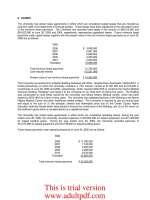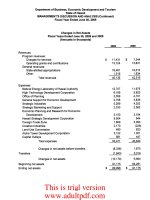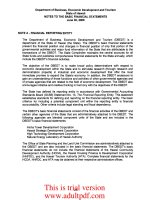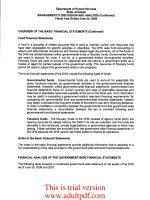FINANCIAL AUDIT OF THE DEPARTMENT OF HUMAN SERVICES STATE OF HAWAII Fiscal Year Ended June 30, 2009_part3 pptx
Bạn đang xem bản rút gọn của tài liệu. Xem và tải ngay bản đầy đủ của tài liệu tại đây (308.08 KB, 11 trang )
Department
of
Human Services
State
of
Hawaii
BALANCE
SHEET
GOVERNMENTAL
FUNDS
June 30,2009
Med·Quest
Human
Services
Special
Revenue
Special
Revenue
General
Fund
Fund
Total
ASSETS
Cash
and
cash
equivalents
$
23,608,724
$
4,131,176
$
25,954,630
$
53,694,530
Receivables
3,267,497
3,613,455
1,084,250
7,965,202
Due
from
other
funds
263,915
263,915
Due
from
State
general
fund
21,711,072
21,711,072
Due
from
other
governments
161,833,656
4,073,934
165,907,590
Total
assets
$
27,140,136
$
191,289,359
$
31,112,814
$
249,542,309
LIABILITIES
AND
FUND
BALANCES
LIABILITIES
Vouchers
payable
$
4,808,657
$
573,288
$
3,860,873
$
9,242,818
Accrued
wages
and
employee
benefits
payable
5,805,232
901,886
3,176,844
9,883,962
Due
to
other
funds
21,974,987
21,974,987
Due
to
other
state
agencies
675,831
48,864,185
49,540,016
Due
to
State
general
fund
2,090,992
2,090,992
Accrued
medical
assistance
payable
68,280,000
140,950,000
209,230,000
Total
liabilities
81,660,712
191
,289,359
29,012,704
301,962,775
FUND
BALANCES
Reserved
for
encumbrances
14,409,444
66,741,495
29,918,893
111,069,832
Unreserved
(68,930,020)
(66,741,495)
(27,818,783)
(163,490,298)
Total
fund
balances
(deficit)
(54,520,576)
2,100,110
(52,420,466)
Total
liabilities
and
fund
balances
$
27,140,136
$
191,289,359
$
31,112,814
$
249,542,309
See accompanying notes to the basic financial statements.
23
This is trial version
www.adultpdf.com
Department
of
Human Services
State
of
Hawaii
RECONCILIATION
OF
THE
GOVERNMENTAL
FUNDS
BALANCE SHEET
TO
THE
STATEMENT OF
NET
ASSETS
June
30,
2009
Total
deficit
in fund balances - governmental funds
Amounts
reported
for
governmental activities in the
statement
of
net
assets are different because:
Capital assets used in governmental activities are not
financial resources and, therefore, are not reported
in the governmental funds.
Capital Assets
Governmental capital assets
Less accumulated depreciation
Accrued compensated absences are not due in the
current period and therefore are not reported
in the governmental funds.
Deficit in
net
assets
of
governmental activities
$ 88,874,998
(50,183,887)
$ (52,420,466)
38,691,111
(16,538,729)
$ (30,268,084)
See accompanying notes to the basic financial statements.
24
This is trial version
www.adultpdf.com
Department
of
Human Services
State
of
Hawaii
STATEMENT OF REVENUES, EXPENDITURES, AND CHANGES
IN
FUND BALANCES
GOVERNMENTAL FUNDS
Fiscal Year Ended June
30,
2009
Med-Quest
Human
Services
Special
Revenue
Special
Revenue
General
Fund
Fund
Total
REVENUES
State-allotted
appropriations
$
679,001,321
$
$ $
679,001,321
Intergovernmental
932,044,704
506,582,580
1,438,627,284
Nonimposed
employee
fringe
benefits
25,628,988
25,628,988
704,630,309
932,044,704
506,582,580
2,143,257,593
EXPENDITURES
Health
care
programs
484,547,077
932,044,704
1,416,591,781
General
welfare
assistance,
employment
and
support
services
117,359,023
414,229,436
531,588,459
Child
welfare
and
adult
community
care
services
98,803,886
67,816,855
166,620,741
Vocational
rehabilitation
and
services
for
the
blind
6,435,784
20,990,325
27,426,109
Youth
prevention,
delinquency
and
correction
services
20,688,550
2,920,422
23,608,972
General
administration
12,365,069
12,365,069
Commission
on
the
status
of
women!
commission
on
fatherhood
123,155
123,155
740,322,544
932,044,704
505,957,038
2,178,324,286
EXCESS
OF
REVENUES
OVER
(UNDER)
EXPENDITURES
(35,692,235)
625,542
(35,066,693)
OTHER
FINANCING
SOURCES
Transfers
in
12,540
12,540
NET
CHANGE
IN
FUND
BALANCES
(35,692,235)
638,082
(35,054,153)
FUND
BALANCES
(DEFICIT)
AT
JULY
1,
2008
(
18,828,341)
1,462,028
(17,366,313)
FUND
BALANCES
(DEFICIT)
AT
JUNE
30,
2009
$
(54,520,576)
$
$
2,100,110
$
(52,420,466)
See accompanying notes to the basic financial statements.
25
This is trial version
www.adultpdf.com
Department
of
Human Services
State
of
Hawaii
RECONCILIATION
OF
THE
CHANGE
IN
FUND
BALANCES
OF
GOVERNMENTAL FUNDS
TO
THE
STATEMENT
OF
ACTIVITIES
Fiscal Year Ended June
30,
2009
Net change in fund balances - total governmental
funds
Amounts
reported
for
governmental activities
in
the statement
of
activities are different because:
Governmental funds report capital outlays as expenditures,
however, in the statement
of
activities the cost
of
those
assets are depreciated over their estimated useful lives as
depreciation expense.
$ (35,054,153)
Expenditures
for
capital assets
Less current year depreciation and other changes
Challge
in
long-term compensated absences reported in the
statement
of
activities do not require the use
of
current
financial resources and therefore are not reported as
expenditures in governmental funds.
Change
in
net assets
of
governmental activities
$ 722,927
(2,725,941) (2,003,014)
(672,501)
$ (37,729,668)
See accompanying notes to the basic financial statements.
26
This is trial version
www.adultpdf.com
Department
of
Human Services
State
of
Hawaii
STATEMENT OF REVENUES AND EXPENDITURES-
BUDGET AND ACTUAL - GENERAL FUND
Fiscal Year Ended June
30,
2009
Original
Final
Actual on
BUdgetary
Basis
Variance
Favorable
(Unfavorable)
REVENUES
State allotments
$ 810,524,450 $ 733,392,440 $ 679,001,321 $ (54,391,119)
EXPENDITURES
Health care programs
566,458,872 486,984,224 403,621,376
83,362,848
General welfare assistance,
employment and support services 118,149,930
118,149,930
113,748,254 4,401,676
Child welfare and adult community
care services 99,189,767 96,588,198 93,265,043
3,323,155
Youth prevention, delinquency
and correction services 17,588,347
17,858,347
17,202,359
655,988
General administration 4,894,274 9,535,401 9,215,583 319,818
Vocational rehabilitation and services
for
the blind
4,085,181
4,118,261
4,048,372 69,889
Commission on the status
of
women I
commission on fatherhood 158,079 158,079 119,168 38,911
810,524,450 733,392,440 641,220,155 92,172,285
EXCESS OF REVENUES OVER
EXPENDITURES
$
$
$
37,781,166 $ 37,781,166
See
accompanying
notes
to
the
basic
financial
statements.
27
This is trial version
www.adultpdf.com
Department
of
Human Services
State
of
Hawaii
STATEMENT OF REVENUES AND EXPENDITURES -
BUDGET AND ACTUAL - SPECIAL REVENUE FUNDS
Fiscal Year Ended June 30, 2009
Actual
on
Budgetary
Basis
Med·Quest
Human
Services
Variance
Special
Revenue
Special
Revenue
Favorable
Original
Final
Fund
Fund
(Unfavorable)
REVENUES
Intergovernmental
revenues
Med-Quest
$
894,688,790
$
894,688,790
$
897,549,922
$ - $
2,861,132
Human
services
273,828,313
273,828,313
247,339,631
(26,488,682)
1,168,517,103
1,168,517,103
897,549,922
247,339,631
(23,627,550)
EXPENDITURES
Health
care
programs
894,688,790 894,688,790
907,218,020
(12,529,230)
General
welfare
assistance,
employment
and
support
services
173,531,542
173,531,542
151,864,862
21,666,680
Child
welfare
and
adult
community
care
services
67,897,960
67,897,960
61,125,727
6,772,233
Vocational
rehabilitation
and
services
for
the
blind
25,334,748
25,334,748
20,412,276
4,922,472
Youth
prevention,
delinquency
and
correction
services
5,182,601 5,182,601
3,595,300
1,587,301
General
administration
1,881,462
1,881,462
1,858,962
22,500
1,168,517,103 1,168,517,103
907,218,020
238,857,127
22,441,956
Excess
of
revenues
over
(under)
expenditures
(9,668,098)
8.482,504
(1,185,594)
OTHER
FINANCING
SOURCES
(USES)
Transfers
in
5,803,251
5,803,251
Transfers
out
(5,790,711
)
(5.790.711
)
(5,790,711
)
5,803,251
12,540
EXCESS
OF
REVENUES
AND
OTHER
SOURCES
OVER
(UNDER)
EXPENDITURES
AND
OTHER
USES
$
$ - $
(15,458,809)
$
14,285,755
$
(1,173,054)
See
accompanying
notes
to
the
basic
financial
statements.
28
This is trial version
www.adultpdf.com
Department
of
Human
Services
State
of
Hawaii
STATEMENT OF FIDUCIARY NET ASSETS - FIDUCIARY FUNDS
June
30,2009
Private
Agency Purpose
Funds Trust Funds
ASSETS
Cash
$
1,263,272
$
11,089
Total assets
$
1,263,272
$
11,089
LIABILITIES
Due
to
individuals
$
912,491
$
Due to others 350,781
Total liabilities
$
1,263,272
Net assets - held
in
trust
$
11,089
See accompanying notes to the basic financial statements.
29
This is trial version
www.adultpdf.com
Department
of
Human Services
State
of
Hawaii
STATEMENT OF CHANGES
IN
FIDUCIARY NET ASSETS - FIDUCIARY FUNDS
Fiscal Year Ended
June
30, 2009
Private
Purpose
Trust Funds
ADDITIONS
Donations
$
95
Total additions
95
DEDUCTIONS
Other
Total deductions
CHANGE IN NET ASSETS
95
Net assets at July
1,
2008
10,994
Net assets at June
30,2009
$
11,089
30
This is trial version
www.adultpdf.com
Department
of
Human Services
State
of
Hawaii
NOTES TO THE BASIC FINANCIAL STATEMENTS
June
30, 2009
NOTE A - FINANCIAL REPORTING ENTITY
The Hawaii State Government Reorganization Act of 1959 (Act
1,
Second Special Session
Laws of Hawaii 1959) created the Department of Social Services and Housing.
In
1987, the
name was changed to the Department of Human Services (DHS). The DHS's mission
is
to
direct its resources toward protecting and helping those least able to care for themselves
and to provide services designed toward achieving self sufficiency for clients as quickly
as
possible. The DHS
is
committed to maintaining a high level of quality, efficiency,
and
effectiveness
in
its services.
The DHS
is
part of the executive branch of the State of Hawaii (State). The DHS's basic
financial statements reflect only its portion of the fund type categories. The State Comptroller
maintains the central accounts for
all
state funds and publishes financial statements for the
State annually which includes the DHS's financial activities.
The accompanying basic financial statements reflect the financial' position and results of
operations of the following activities of the
DHS:
Health Care Programs: The Med-QUEST Division administers the State's Medicaid
program through which healthcare
is
provided to the low-income population. The Medicaid
program
is
jointly financed
by
the State and the federal government. The Division develops
and maintains working relationships with health plans, providers, federal
and
state
authorities, community agencies, client advocacy groups,
and
others. Healthcare
coverage
is
provided through either fee-for-service payments to healthcare providers or
contracts with managed care health plans. The State's Children Health Insurance Program
was established to expand health coverage to more children whose families may
be
working but do not earn enough to pay for health coverage for their children. The
Division's operations are reported
in
the general, special revenue,
and
agency funds.
General Welfare Assistance, Employment and Support Services: The Benefit,
Employment and Support Services Division provides monthly benefits to assist eligible
clients with such essentials
as
food, clothing, shelter, emergency assistance,
child
care,
and work support,
as
well
as
employment and training to help families attain self-
sufficiency. Cash benefits are provided to individuals
and
families through the Temporary
Assistance to Needy Families, Temporary Assistance
to
Other Needy Families, General
Assistance,
and
Assistance to the Aged, Blind, and Disabled programs,
as
well
as
the Low
Income Home Energy Program and Child Care Connection Hawaii. The Food Stamp
program helps to ensure that no one goes hungry. The First-To-Work, Food Stamp
Employment and Empowerment' Hawaii Work programs provide job readiness, job
development, job placement, case management, and other supportive services to ensure
that families
on
public welfare are adequately prepared to
end
dependency,
as
well
as
providing a variety of at-risk youth and family strengthening programs to prevent family
dependence. The Division's operations are reported
in
the general, special revenue,
and
agency funds.
31
This is trial version
www.adultpdf.com
Department
of
Human Services
State
of
Hawaii
NOTES TO THE BASIC FINANCIAL STATEMENTS
June
30,2009
NOTE A - FINANCIAL REPORTING ENTITY (Continued)
Child Welfare and
Adult
Community Care Services: The Social Services Division
provides social services programs to ensure the health and safety of those least able
to
protect themselves from abuse and neglect. The Child Welfare Services (CWS) program
provides services to ensure the safety
and
permanency of children
in
their
own
homes
or,
when necessary,
in
out-of-home placements. The program
is
community-based
and
neighbor-focused with many partnerships and collaborations with the private and public
sectors. Services are focused
on
empowering families
and
building upon family strengths.
When children cannot
be
safely returned to their family, the CWS program proceeds with
permanent placement through adoption, legal guardianship, or other substitute long-term
care, including independent living. The program also licenses foster families, boarding
homes, group homes, and child placing-organizations. The Adult Protective Services
program provides crisis intervention, including investigation
and
emergency services, to
dependent adults who are reported to
be
abused, neglected, or financially exploited by
others or seriously endangered due to self-neglect. The Home
and
Community-Based
Services program provides comprehensive home
and
community-based services to
disabled adults and children to enable them to live
in
their homes or
in
the community
as
long
as
possible to prevent premature institutionalization. The Division's operations
are
reported
in
the general, special revenue, and agency funds.
Vocational Rehabilitation and Services
for
the
Blind: The Vocational Rehabilitation
and Services for the Blind Division administers programs that provide rehabilitation
services to assist eligible persons with disabilities to secure employment and to lead full
and independent lives. The Vocational Rehabilitation (VR) program offers vocational
evaluation, planning, counseling, treatment, training, job placement, and follow-up services
to persons with physical or mental disabilities to enable them to become employed. The
economic benefits of the VR program include increased earnings
and
purchasing power,
increased tax revenues, and decreased dependency on public assistance. The Services to
the Blind program, called Ho'opono, enables visually impaired adults to attain maximum
vocational functional independence by providing varied services including vocational,
counseling, assistive technology, and social and independent living skills training. Persons
with visual impairment are also assisted
in
establishing and operating vending facilities.
The Disability Determination program determines eligibility for Social Security Disability
Insurance
and
Supplemental Security Income benefits under the federal Social Security
Program. The Division's operations are reported
in
the
general, special revenue,
and
agency funds.
Youth
Prevention, Delinquency and Correction Services: The Office of Youth Services
(OYS) develops and provides a continuum of services for youth at risk to prevent
delinquency and to reduce recidivism through prevention, rehabilitation,
and
treatment
services. Youth's needs, from prevention to incarceration to aftercare, are addressed
through programs such
as
the Youth Services Centers, the Youth Gang Response
System, and Ho'okala Adolescent Diversion as alternative to incarceration through
32
This is trial version
www.adultpdf.com
Department
of
Human Services
State
of
Hawaii
NOTES TO THE BASIC FINANCIAL STATEMENTS
June
30, 2009
NOTE A - FINANCIAL REPORTING ENTITY (Continued)
immediate intervention services; non-residential and in-community aftercare services
to
prevent further incarceration;
and
community based residential services
as
an
alternative
to incarceration. OYS also manages
and
operates the Hawaii Youth Correctional Facility
(HYCF) to provide safe and secure housing for the most violent
and
dangerous juvenile
offenders. Although a core responsibility of OYS
is
to manage and operate HYCF, the
agency places great emphasis
on
providing and supporting "front end" prevention,
diversion, and intervention services. Incarcerated youth are provided counseling,
treatment, and educational services for redirection
and
rehabilitation. The Division's
operations are reported
in
the general, special revenue,
and
agency funds.
General Administration: General administration includes the five staff offices that support
the DHS administration, operating divisions, and attached agencies. The Administrative
Appeals Office (AAO) provides administrative due process hearings for three departmental
divisions - Benefit Employment and Support Services, Med-QUEST,
and
Social Services.
The AAO also serves
as
the rules coordinator for the DHS and reviews administrative
proceedings for the adoption, modification, or repeal of departmental rules. AAO
is
also
responsible for establishing a mediation process for the
DHS.
The Fiscal Management
Office (FMO) provides staff assistance and advisory services for the administrative
functions of fiscal management and housekeeping services. FMO formulates policies
and
procedures and administers the DHS's central accounting, funds management, client
and
vendor payment, employee payroll, inventory management, contracting, purchasing,
records management, office space allocation, and central mail distribution function. The
Management Services Office (MSO) provides research, budget, quality assurance,
program and financial evaluation, and assessment capabilities to enable the DHS
to
oversee its programs and to make effective decisions concerning those programs. MSO
conducts studies, analyses, evaluations, and reviews
to
ensure regulatory compliance,
achievement of stated goals and objectives, and effective and efficient departmental
programs and services and use of resources. The Office of Information Technology (OIT)
is
responsible for the overall administration, planning, direction, management,
development, implementation, and maintenance of
all
information technology
and
information systems processing for the DHS statewide. The Personnel Office oversees the
personnel programs of the DHS, including recruitment, examination, placement, position
description, classification and pricing analysis, labor relations, civil rights, employee safety
and relations, employee training and development, personnel transactions,
and
maintenance of personnel records. Those operations are reported
in
the general
and
special revenue funds.
Commission
on
the Status
of
Women: The Commission works for equality for women
and girls
in
the State
by
acting
as
a catalyst for positive change through advocacy,
education, collaboration, and program development. The Commission acts
as
a central
clearinghouse and coordinating body for governmental
and
nongovernmental activities
and information relating to the status of women
and
creates public awareness and
understanding of the responsibilities, needs, potential,
and
contributions of women and
their roles
in
a changing society. The Commission's operations are reported
in
the general
and special revenue funds.
33
This is trial version
www.adultpdf.com









